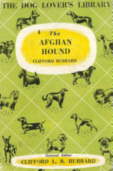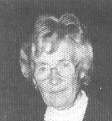(Afghan Hound Database and Breed Information Exchange)
THE ORIGINS OF THE AFGHAN HOUND (Author Steve Tillotson, a work in progress 3/30/2010) (Page 1) Furthermore, our interest is not limited to the genetic origins of the breed. Dogs and people live together. We are lacking first hand reports from the region from which our breed originates. There have been some excursions to Afghanistan in modern times (say the last 50 years) that have provided some insight on the environment from whence our hounds come, but nothing substantial. Today it seems to all intents and purpose The Afghan Hound does not exist in Afghanistan. Yes we have the "Tazi", but we have no documentation of his breeding (pedigree), we have no reliable information as regards his origins, and the term "Tazi" is not exclusively applied to The Afghan Hound, but to other hound-type breeds as well. As is apparent, one could write a book simply on the subject of "The Origin Of The Afghan Hound". It is a huge subject and promises to articulate many fascinating aspects of our breeds history. I would truly appreciate the contribution of any/all readers to the further development of this section of our breed history. Let's start with some quotations from some famous Afghan Hound people about the origins of the breed...
Well that last quotation is a bit daunting to someone seeking to write about the origins of The Afghan Hound, Especially when you consider who Evelyn Denyer was. At the time she was the Secretary and a founder member of The Afghan Hound Club (AHC) Of England, the first Afghan Hound breed club in in the world, formed in 1925. Ms Denyer won the first CC's (Challenge Certificates) at Crufts in 1926 the first time The Kennel Club granted CC's for the breed, the KC having recognized the breed only one year earlier in 1925. Ms Denyer was the first person to be granted an affix in the breed ('of Kaf") and bred exclusively from Bell Murray Stock. Ms Denyer and the Afghan Hound Club drew up the first breed standard in 1925, which is also known as "The Denyer Standard" Where to start? I am going to start with a lead from my friends in Saluki's. Several years ago I hosted a website for the UK Saluki and Gazelle Hound Club and the specialist magazine Saluki International. I was very impressed with the large amount of information available on the Saluki. Several authors in the breed having spent siginifcant time living with the dogs in the region from whence they come. I am thrilled to be currently enjoying correspondence with Sir Terence Clark who has undertaken such valuable research and reporting for the Saluki community as well as having lived in the region from where our hounds come. So let's start with Sir Terence 1. A START Allthough the first section is written by a Saluki expert for the Saluki communty, I think it helps us by serving as a primer on the region and its hounds. You will recognize many of the photographs in the article being of the Tazi/Tazy type. Just to remind us all, "Tazi" is not a word used exclusively in respect of The Afghan Hound. in Helsinki, Finland on 1 July 2008. THE SALUKI IN THE COUNTRIES OF ORIGIN by Sir Terence Clark 1.2. SIR TERRENCE  3/30/2010 Sir Terrence kindly gave me the following short statement in response to a question about our breeds history - "I regret very much that I have not been able to do any first-hand research on the Tazi in Afghanistan, though I have been around some of the neighbouring countries, not least because I am interested in the process of gradation between the Middle Eastern Saluki and the similar hunting hounds on the periphery of its core area. You will have seen the recent study by Wayne et al which seems to put the origin of dogs back into the Middle East, strengthening the case already indicated by archaeology for the first emergence of a Saluki-like hunting hound there. Judging largely by photos from Afghanistan, it seems to me that the native hound exhibits a range of variants, some of which appear almost identical with Salukis, while others exhibit some significant differences. It would be interesting to establish, perhaps through DNA, to what the differences are due, e g to the admixture to a greater or lesser degree of another breed/type of dog. If so, is the admixture similar to that which gives the Central Asian Tazy some of its variations from the Saluki? If so, is it repeated in e g the XiGou (Slender Dogs) of western China? So, lots of questions without many answers so far, though Dr Peter Savolainen and others are working on the DNA from right across this region". I am hoping for some more information from Sir Terence as we progress. In the interim you might enjoy a visit to the following websites Sir Terence's website Review of Wayne's Papers by Jody Haynes (Scroll the page a bit to get to articles) Sir Terence authored another article in which he referenced our own Daphne Gie (Jagai Afghan Hounds UK) and her Afghanistan imports in the 1960's The northern frontiers of Salukidom 1.3 OUR BREED AUTHORS Several of our breed authors have endeavoured to document our breed history, for which she should be eternally grateful. Most of them touched upon the origin of our breed and mainly covered a common ground. I summarize some of these earlier writings below. 1.3.1 Clifford "Doggie" Hubbard. (UK)  Doggie Hubbard wrote the first book on the breed "The Afghan Hound Handbook", published in 1951,  In addition to Doggie's fame as author of the first book on the breed, he is famous (to me) for something else unique about him - He met and knew Mary Amps of Ghazni Afghan Hounds. Not only did Doggie know Mrs Amps, he worked for her when he was a boy in her kennel/pet shop/dog parlour that was located in Bath, in the South West of England. It was interesting to sit with Doggie in his home in Aberythswith in Wales and discuss The Afghan Hound and his time with Mary Amps. It was during one such visit where Doggie told me that as a boy of 14 years of age he walked from Bath to London (about a 100 mile walk!) in search of work. He also worked as a stoker on a merchant ship and flew with the RAF. A remarkable man who knew more about dog books than anyone, ever. period. I quote from Doggie's book from the section "Origin and History" "The breed is obviously a very old one but it is impossible on the evidence so far revealed for us to say how old", Doggie went on to document some findings of his research into the origins of The Afghan Hound, findings that have since been re-used in breed books that came out 25 years later. So not much has changed since 1951 in terms of writers being able to document the origins of our breed. 1.3..2 Margaret Niblock (UK)  Margaret's book is titled "The Afghan Hound - A Definitive Study". I quote from the "Preface" in Margaret's book. "It was astonishing and intriguing to find so many weird inaccuraties, many gathering more and more colourful exaggeratrions over the years to become purely fanciful myths. Let us by all means keep the fairy tales and legends told by the Afghans themselves, but we must have the facts of the foundation of the breed in this country correct and in perspective". Later in her book (page 13) Margaret writes "The eaarliest and to date the only pictorial record of anything resembling the Afghan Hound appeard in Letters Written in a Mahratta Camp During the Year 1809 by Thomas Duer Broughton, published in 1813. Reproduced in 1951 by Clifford Hubbard in his book The Afghan Hound Handbook, entitled "A Meenah Of Jajurth" it shows a native solder with his dog. Margaret continues by commenting that allowing for artistic licence, the illustration bears a certain resemblance to the present-day (1980) Afghan Hound" Related content: Early Afghan Hounds The "myth" of the Sinai Penninsula (by Steve Tillotson, November 2013) Hyland Afghan Painting afghan hound times, Origins of the afghan houndt afghan hound times, Origins of the afghan houndt |